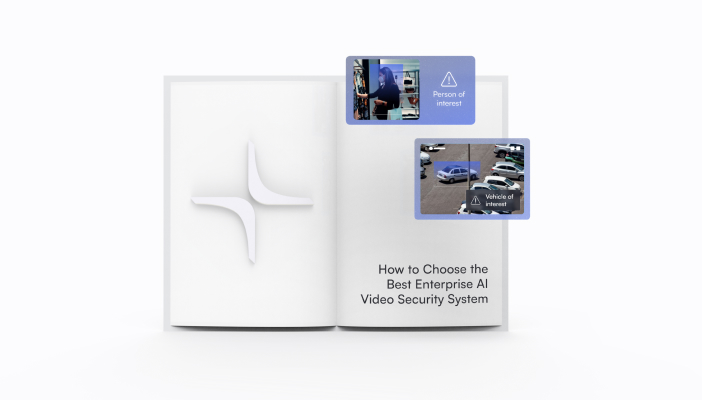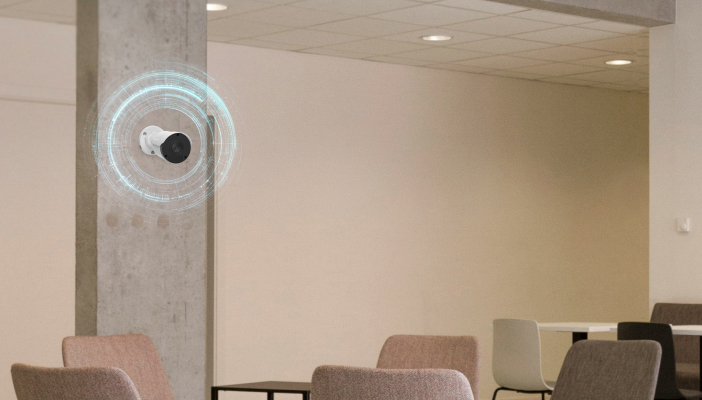Enterprise AI video security systems significantly enhance organizational security and operational efficiency by offering advanced detection capabilities at an unprecedented scale. But how do you determine what is best for your organization?
Introduction
Safeguarding your business and physical environment is more important than ever. Enterprise AI video security systems are at the forefront, offering sophisticated tools to enhance visibility, threat detection, and operations. However, with so many options and many claiming to have AI capabilities, how do you determine which solution is best from a video security and AI performance standpoint?
In this blog post, we will provide a comprehensive guide on evaluating and choosing the best AI video security solution for your organization, ensuring you make a well-rounded decision that aligns with your security needs and business objectives now and in the future.
Key Factors to Consider When Evaluating Enterprise AI Video Security Systems
1. Accuracy and Performance
Video security and AI systems can vary significantly in performance, accuracy, and overall user experience. Testing event detection capabilities are critical when selecting an AI video security solution. Many of today's systems offer some level of motion, people, and vehicle detection. However, when evaluating a proper AI solution, it is essential to identify a vendor that provides capabilities far beyond this, such as activity and behavior-based alerts. If a vendor offers this capability, it indicates their commitment to developing AI solutions that will automate, streamline, and inform your team to be more proactive.
An AI video security system should provide highly specific alert capabilities and accurately identify various objects and activities within its field of view. For instance, it is important that the system can distinguish between a person loitering or someone entering your property with a weapon. Both events vary in terms of potential threats, so selecting a solution that can understand what is happening within a scene will improve visibility and response when incidents arise.
Most AI systems today require significant investments in servers and processors to run sophisticated AI models. Other systems where the AI is done on the camera or straight to the cloud are severely limited in processing power and speed due to integrated chipsets. Identifying a solution built on a distributed AI architecture provides much better performance and efficiency, as video processing happens locally utilizing GPUs, and the cloud provides additional processing power by distributing the workload to the cloud and other connected devices.
Lastly, consider the system's precision and recall rates when testing AI performance and accuracy. These metrics will tell you how often the system is correct in its detection versus how often it misses or misidentifies objects. Keep in mind, AI within video security is still new and accuracy can vary based on a myriad of different factors, so testing will be key with any solution. When conducting a test, ensure the options are set up exactly the same way for a fair apples-to-apples comparison.
2. Integration Capabilities
A superior AI video security system should seamlessly integrate with your existing security infrastructure. This includes compatibility with current cameras, sensors, and other management software. The system's ability to scale according to your organization's growth is crucial, as is the availability of robust open APIs that allow for custom integrations, such as access control or the ability to integrate with any external third-party system to assist with video search and investigations.
For instance, if you are an organization with multiple locations, selecting a cloud-connected solution that allows you to use existing cameras will provide a much easier deployment and management experience since you don't have to rip-and-replace cameras or deploy siloed on-premise systems. Additionally, a solution with open APIs and integration capabilities enables the system to integrate with your organization’s tech stack and provide added value, not just capturing and storing video. Selecting a flexible AI video security solution will allow your organization to receive immediate value and solve potential new use cases as they emerge.
3. Advanced Analytics and Features
The real power of an AI-driven security system lies in its real-time analytic capability, as it allows for the immediate identification and escalation of potential threats. However, as mentioned previously, not all AI video security systems are built or perform the same. Many of today's "AI systems" have similar feature sets, such as motion, people, and vehicle detection, derived from static, off-the-shelf models. This causes many offerings to look the same or provide the same level of performance, making it challenging to identify what separates one AI video security provider from another.
When evaluating AI features, first, determine if the AI can solve your primary use case, and second, determine if the AI models are proprietary and built in-house by the vendor. Selecting a vendor that builds its AI models from the ground up shows a commitment to improving security and safety with AI technology versus building reactive hardware solutions. Next, determine if the models are static or self-learning. Static models rarely see updates and follow a one-size-fits-all approach to AI. When a solution uses a self-learning AI model, the AI automatically adapts to your environment, providing better performance and accuracy over time. Lastly, look at the capabilities offered, such as:
- Facial recognition and alerts for untrusted people
- Vehicle recognition with make, model, color, and LPR alerts
- Object and person tracking across cameras
- Spatial analysis, such as heatmaps, person or vehicle path, and occupancy counts
- Behavioral analysis such as trespassing, loitering, line crossing, speeding, and near-miss accidents
- Advanced AI capabilities such as gun detection, PPE detection, fire detection, tailgating, and custom objects
- AI dashboards to collect data from video to drive smarter operational decisions
These are just a small subset of AI features that should address most use cases, but they will vary depending on your specific organizational needs. Additionally, evaluate the granularity of the AI features and how they translate into alerts and investigations. Having more control over how you use the system's AI capabilities provides significant benefits, helping to streamline operational tasks and make your security and safety efforts much more proactive.
4. Data Management and Security
With increasing digital threats, the cybersecurity measures of an AI video security system are non-negotiable. Ensure the system offers end-to-end encryption for storing and transmitting data. Selecting a solution offering hybrid-cloud architecture is ideal, as it provides better security locally and in the cloud and better video processing and system management than pure cloud or on-premises options.
The vendor you are evaluating should also have standard system security features, including automatic firmware updates, single sign-on, audit logs, redundant cloud backup, role-based access control, and no port forwarding or inbound network traffic.
Additionally, assess the system's compliance with relevant data protection regulations, such as NDAA, SOC2, and other applicable compliance standards for your organization.
5. User Interface and Operational Ease
The system's usability plays a critical role in its effectiveness. A user-friendly interface empowers your security personnel to operate the system efficiently without extensive training. This leads to higher system adoption rates, higher return on investment, and safer, more efficient environments overall. The key features to test when evaluating a solution should be alerts, video search tools, video walls, video sharing, and dashboards. These are the most commonly used features when interacting with a video security system. Focusing your testing efforts on these essential features will save you time and energy, ensuring your evaluation process is time-efficient and thorough.
Remote access and management should be mandatory, especially if you have multiple locations. In today's modern world, using your system, managing your organization's security, and collaborating with others from any web browser or mobile device is essential.
Lastly, consider the level of customer support the vendor provides, as this will be crucial for troubleshooting. Also, consider whether the system receives automatic updates to reduce the need for manual maintenance.
How to Determine Which AI Video Security Solution Is Better
To effectively select the best enterprise AI video security system, conduct pilot tests with shortlisted systems under various environmental conditions to directly compare their performance. For proper testing, establish a baseline testing environment that is set up exactly the same, as different cameras, installation locations, and lighting conditions will yield different results. Use standardized benchmarks to evaluate how well each system meets your security requirements and gather end-user feedback to assess ease of use and functionality. Finally, perform a detailed cost-benefit analysis, factoring in the total cost of ownership, so you can determine that the chosen system offers the best value for your investment over multiple years.
Conclusion
Choosing the right enterprise AI video security system is crucial for enhancing your organization's security and operational efficiency. By carefully considering each of the factors outlined above, you can select a system that meets your current security needs and scales as your organization grows. Remember, the goal is to find a reliable, intelligent, cost-effective solution that provides peace of mind, enhanced situational awareness, and proactive visibility your organization requires.
Looking for the best AI video security solution?
Related Articles
Security management
Jul 17, 2024
The Hidden Costs of Video Surveillance Systems
Visual intelligence
Jun 28, 2024
The 4 Key Features Every AI Security Camera System Should Have
Product news
Jun 20, 2024
New Lumana Updates: Motion and Enhanced Face Search, Custom Alert Messages, and Achieving Zero Bandwidth
Sign up for the Webinar
Submitted information will be used in accordance with our Privacy Policy.
Enterprise AI video security systems significantly enhance organizational security and operational efficiency by offering advanced detection capabilities at an unprecedented scale. But how do you determine what is best for your organization?
Introduction
Safeguarding your business and physical environment is more important than ever. Enterprise AI video security systems are at the forefront, offering sophisticated tools to enhance visibility, threat detection, and operations. However, with so many options and many claiming to have AI capabilities, how do you determine which solution is best from a video security and AI performance standpoint?
In this blog post, we will provide a comprehensive guide on evaluating and choosing the best AI video security solution for your organization, ensuring you make a well-rounded decision that aligns with your security needs and business objectives now and in the future.
Key Factors to Consider When Evaluating Enterprise AI Video Security Systems
1. Accuracy and Performance
Video security and AI systems can vary significantly in performance, accuracy, and overall user experience. Testing event detection capabilities are critical when selecting an AI video security solution. Many of today's systems offer some level of motion, people, and vehicle detection. However, when evaluating a proper AI solution, it is essential to identify a vendor that provides capabilities far beyond this, such as activity and behavior-based alerts. If a vendor offers this capability, it indicates their commitment to developing AI solutions that will automate, streamline, and inform your team to be more proactive.
An AI video security system should provide highly specific alert capabilities and accurately identify various objects and activities within its field of view. For instance, it is important that the system can distinguish between a person loitering or someone entering your property with a weapon. Both events vary in terms of potential threats, so selecting a solution that can understand what is happening within a scene will improve visibility and response when incidents arise.
Most AI systems today require significant investments in servers and processors to run sophisticated AI models. Other systems where the AI is done on the camera or straight to the cloud are severely limited in processing power and speed due to integrated chipsets. Identifying a solution built on a distributed AI architecture provides much better performance and efficiency, as video processing happens locally utilizing GPUs, and the cloud provides additional processing power by distributing the workload to the cloud and other connected devices.
Lastly, consider the system's precision and recall rates when testing AI performance and accuracy. These metrics will tell you how often the system is correct in its detection versus how often it misses or misidentifies objects. Keep in mind, AI within video security is still new and accuracy can vary based on a myriad of different factors, so testing will be key with any solution. When conducting a test, ensure the options are set up exactly the same way for a fair apples-to-apples comparison.
2. Integration Capabilities
A superior AI video security system should seamlessly integrate with your existing security infrastructure. This includes compatibility with current cameras, sensors, and other management software. The system's ability to scale according to your organization's growth is crucial, as is the availability of robust open APIs that allow for custom integrations, such as access control or the ability to integrate with any external third-party system to assist with video search and investigations.
For instance, if you are an organization with multiple locations, selecting a cloud-connected solution that allows you to use existing cameras will provide a much easier deployment and management experience since you don't have to rip-and-replace cameras or deploy siloed on-premise systems. Additionally, a solution with open APIs and integration capabilities enables the system to integrate with your organization’s tech stack and provide added value, not just capturing and storing video. Selecting a flexible AI video security solution will allow your organization to receive immediate value and solve potential new use cases as they emerge.
3. Advanced Analytics and Features
The real power of an AI-driven security system lies in its real-time analytic capability, as it allows for the immediate identification and escalation of potential threats. However, as mentioned previously, not all AI video security systems are built or perform the same. Many of today's "AI systems" have similar feature sets, such as motion, people, and vehicle detection, derived from static, off-the-shelf models. This causes many offerings to look the same or provide the same level of performance, making it challenging to identify what separates one AI video security provider from another.
When evaluating AI features, first, determine if the AI can solve your primary use case, and second, determine if the AI models are proprietary and built in-house by the vendor. Selecting a vendor that builds its AI models from the ground up shows a commitment to improving security and safety with AI technology versus building reactive hardware solutions. Next, determine if the models are static or self-learning. Static models rarely see updates and follow a one-size-fits-all approach to AI. When a solution uses a self-learning AI model, the AI automatically adapts to your environment, providing better performance and accuracy over time. Lastly, look at the capabilities offered, such as:
- Facial recognition and alerts for untrusted people
- Vehicle recognition with make, model, color, and LPR alerts
- Object and person tracking across cameras
- Spatial analysis, such as heatmaps, person or vehicle path, and occupancy counts
- Behavioral analysis such as trespassing, loitering, line crossing, speeding, and near-miss accidents
- Advanced AI capabilities such as gun detection, PPE detection, fire detection, tailgating, and custom objects
- AI dashboards to collect data from video to drive smarter operational decisions
These are just a small subset of AI features that should address most use cases, but they will vary depending on your specific organizational needs. Additionally, evaluate the granularity of the AI features and how they translate into alerts and investigations. Having more control over how you use the system's AI capabilities provides significant benefits, helping to streamline operational tasks and make your security and safety efforts much more proactive.
4. Data Management and Security
With increasing digital threats, the cybersecurity measures of an AI video security system are non-negotiable. Ensure the system offers end-to-end encryption for storing and transmitting data. Selecting a solution offering hybrid-cloud architecture is ideal, as it provides better security locally and in the cloud and better video processing and system management than pure cloud or on-premises options.
The vendor you are evaluating should also have standard system security features, including automatic firmware updates, single sign-on, audit logs, redundant cloud backup, role-based access control, and no port forwarding or inbound network traffic.
Additionally, assess the system's compliance with relevant data protection regulations, such as NDAA, SOC2, and other applicable compliance standards for your organization.
5. User Interface and Operational Ease
The system's usability plays a critical role in its effectiveness. A user-friendly interface empowers your security personnel to operate the system efficiently without extensive training. This leads to higher system adoption rates, higher return on investment, and safer, more efficient environments overall. The key features to test when evaluating a solution should be alerts, video search tools, video walls, video sharing, and dashboards. These are the most commonly used features when interacting with a video security system. Focusing your testing efforts on these essential features will save you time and energy, ensuring your evaluation process is time-efficient and thorough.
Remote access and management should be mandatory, especially if you have multiple locations. In today's modern world, using your system, managing your organization's security, and collaborating with others from any web browser or mobile device is essential.
Lastly, consider the level of customer support the vendor provides, as this will be crucial for troubleshooting. Also, consider whether the system receives automatic updates to reduce the need for manual maintenance.
How to Determine Which AI Video Security Solution Is Better
To effectively select the best enterprise AI video security system, conduct pilot tests with shortlisted systems under various environmental conditions to directly compare their performance. For proper testing, establish a baseline testing environment that is set up exactly the same, as different cameras, installation locations, and lighting conditions will yield different results. Use standardized benchmarks to evaluate how well each system meets your security requirements and gather end-user feedback to assess ease of use and functionality. Finally, perform a detailed cost-benefit analysis, factoring in the total cost of ownership, so you can determine that the chosen system offers the best value for your investment over multiple years.
Conclusion
Choosing the right enterprise AI video security system is crucial for enhancing your organization's security and operational efficiency. By carefully considering each of the factors outlined above, you can select a system that meets your current security needs and scales as your organization grows. Remember, the goal is to find a reliable, intelligent, cost-effective solution that provides peace of mind, enhanced situational awareness, and proactive visibility your organization requires.








